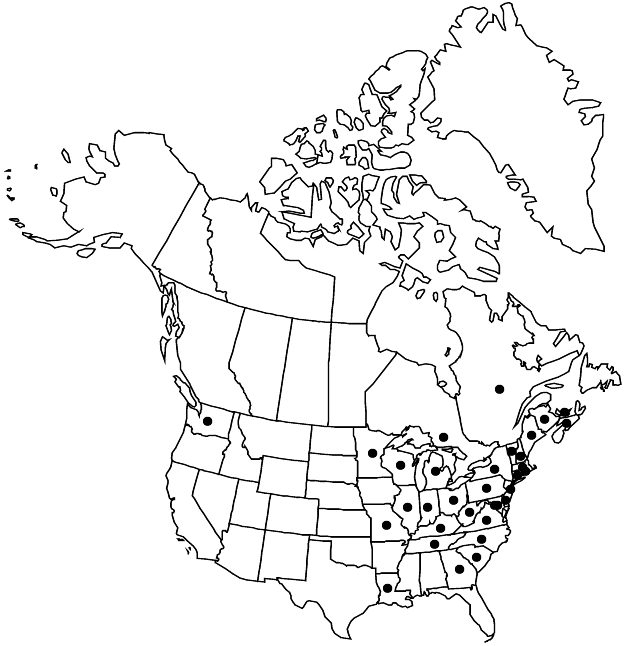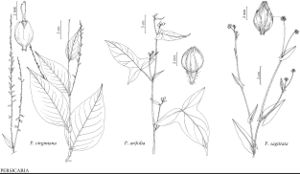Difference between revisions of "Persicaria arifolia"
Acta Univ. Upsal., Symb. Bot. Upsal. 22: 72. 1978.
FNA>Volume Importer |
FNA>Volume Importer |
||
| Line 15: | Line 15: | ||
|name=Polygonum arifolium var. lentiforme | |name=Polygonum arifolium var. lentiforme | ||
|authority=Fernald & Griscom | |authority=Fernald & Griscom | ||
| − | }}{{Treatment/ID/Synonym | + | }} {{Treatment/ID/Synonym |
|name=Polygonum arifolium var. pubescens | |name=Polygonum arifolium var. pubescens | ||
|authority=(R. Keller) Fernald | |authority=(R. Keller) Fernald | ||
| − | }}{{Treatment/ID/Synonym | + | }} {{Treatment/ID/Synonym |
|name=Polygonum sagittatum var. pubescens | |name=Polygonum sagittatum var. pubescens | ||
|authority=R. Keller | |authority=R. Keller | ||
| − | }}{{Treatment/ID/Synonym | + | }} {{Treatment/ID/Synonym |
|name=Tracaulon arifolium | |name=Tracaulon arifolium | ||
|authority=unknown | |authority=unknown | ||
| − | }}{{Treatment/ID/Synonym | + | }} {{Treatment/ID/Synonym |
|name=Truellum arifolium | |name=Truellum arifolium | ||
|authority=unknown | |authority=unknown | ||
| Line 65: | Line 65: | ||
|publication year=1978 | |publication year=1978 | ||
|special status= | |special status= | ||
| − | |source xml=https://jpend@bitbucket.org/aafc-mbb/fna-data-curation.git/src/ | + | |source xml=https://jpend@bitbucket.org/aafc-mbb/fna-data-curation.git/src/8f726806613d60c220dc4493de13607dd3150896/coarse_grained_fna_xml/V5/V5_1180.xml |
|subfamily=Polygonaceae subfam. Polygonoideae | |subfamily=Polygonaceae subfam. Polygonoideae | ||
|genus=Persicaria | |genus=Persicaria | ||
Revision as of 17:36, 18 September 2019
Plants annual, 2–15 dm; roots also often arising from proximal nodes. Stems scandent, ribbed, glabrous; prickles 0.5–1 mm. Leaves: ocrea tan or brownish, cylindric, 8–15 mm, chartaceous, base inflated or not, with prickles, margins oblique, ciliate with bristles 0.5–2.5 mm, surface glabrous or appressed- to spreading-pubescent; petiole 1–7 cm; blade broadly hastate to hastate-cordate or triangular, (2–)6.5–13(–18) × (1–)6–11(–16) cm, base truncate to truncate-cordate, margins broadly hastate with lobes divergent, ciliate, sometimes also retrorsely prickly, apex acuminate, faces appressed-pubescent or, rarely, glabrous adaxially, stellate-pubescent or, rarely, glabrous abaxially, major veins often bearing prickles. Inflorescences capitate or paniclelike, uninterrupted, 5–12 × 3–8 mm; peduncle 10–80 mm, retrorsely prickly proximally, stellate-pubescent and stipitate-glandular distally, glands red or pink; ocreolae usually overlapping, sometimes not overlapping proximally, margins eciliate or ciliate with bristles to 0.5 mm. Pedicels mostly ascending, 2–3 mm. Flowers 2–4 per ocreate fascicle; perianth pink or red, often whitish green proximally, glabrous, accrescent, not becoming blue and fleshy in fruit; tepals 4, connate 1/3–1/2 their length, broadly elliptic, 5–6 mm, apex acute to obtuse; stamens (6–)8, filaments distinct, free; anthers pink, elliptic; styles 2, distinct. Achenes included, dark brown to black, biconvex, 3.5–6 × 3–4 mm, shiny, smooth.
Phenology: Flowering Jul–Oct.
Habitat: Shaded swamps, ponds, tidal marshes along rivers, wet ravines in forests
Elevation: 0-600 m
Distribution

N.B., N.S., Ont., P.E.I., Que., Conn., Del., D.C., Ga., Ill., Ind., Ky., La., Maine, Md., Mass., Mich., Minn., Mo., N.H., N.J., N.Y., N.C., Ohio, Pa., R.I., S.C., Tenn., Vt., Va., Wash., W.Va., Wis.
Discussion
Selected References
None.
